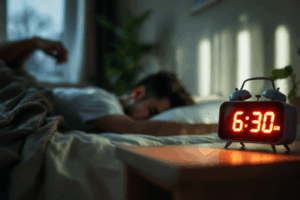
Present Simple Tense 1
English Blogs “Let’s Learn, Explore, and Connect to the World” Present Simple Tense 1 I. Introduction to the Present Simple Tense in English Mastering the


 As the sun sets earlier and nights stretch longer, it’s not uncommon for many people to feel a shift in their mood and energy. This seasonal change can bring on a feeling of sluggishness and even a bit of downheartedness. But for some, these changes are more significant, leading to a type of depression known as Seasonal Affective Disorder (SAD).
As the sun sets earlier and nights stretch longer, it’s not uncommon for many people to feel a shift in their mood and energy. This seasonal change can bring on a feeling of sluggishness and even a bit of downheartedness. But for some, these changes are more significant, leading to a type of depression known as Seasonal Affective Disorder (SAD).
Seasonal Affective Disorder (SAD) remains one of the most intriguing yet misunderstood mental health conditions, often dismissed as mere “winter blues.” However, SAD is a distinct type of depression that recurs at specific times of the year, primarily during the fall and winter months when daylight is scarce. Contrary to common belief, SAD can also manifest in the spring and summer, though less frequently. This cyclical pattern significantly differentiates SAD from other forms of depression, impacting an individual’s mood, energy levels, and overall quality of life during specific seasons.
 Despite its significant impact, many people are unaware of the condition’s complexity and the seriousness with which it should be treated. SAD goes beyond feeling down during colder, darker days; it encompasses a range of symptoms that can affect every aspect of one’s life, from sleep patterns to social interactions. As we delve into the nuances of Seasonal Affective Disorder, this blog aims to shed light on its symptoms, potential causes, and the various treatment options available, offering hope and guidance for those affected by this seasonal depression. Understanding SAD is the first step toward effective management and coping strategies, ensuring those affected can navigate their symptoms with knowledge and support.
Despite its significant impact, many people are unaware of the condition’s complexity and the seriousness with which it should be treated. SAD goes beyond feeling down during colder, darker days; it encompasses a range of symptoms that can affect every aspect of one’s life, from sleep patterns to social interactions. As we delve into the nuances of Seasonal Affective Disorder, this blog aims to shed light on its symptoms, potential causes, and the various treatment options available, offering hope and guidance for those affected by this seasonal depression. Understanding SAD is the first step toward effective management and coping strategies, ensuring those affected can navigate their symptoms with knowledge and support.
 Seasonal Affective Disorder (SAD) is a family of depression that manifests during a particular season, typically in autumn and winter, when daylight hours shorten and exposure to sunlight decreases. However, a less common form of SAD occurs during the spring and summer months, demonstrating that this condition can impact individuals differently based on the season. Unlike the mild winter blues that many people experience with the change of seasons, SAD involves significant mood changes and symptoms that can affect a person’s daily functioning.
Seasonal Affective Disorder (SAD) is a family of depression that manifests during a particular season, typically in autumn and winter, when daylight hours shorten and exposure to sunlight decreases. However, a less common form of SAD occurs during the spring and summer months, demonstrating that this condition can impact individuals differently based on the season. Unlike the mild winter blues that many people experience with the change of seasons, SAD involves significant mood changes and symptoms that can affect a person’s daily functioning.
 The prevalence of SAD varies by geography and age, with individuals living farther from the equator and younger adults being more susceptible. Women are also diagnosed with SAD at a higher rate than men. This condition highlights the complex interplay between our environment, biological rhythms, and mental health, underscoring the need for a deeper understanding and awareness of SAD.
The prevalence of SAD varies by geography and age, with individuals living farther from the equator and younger adults being more susceptible. Women are also diagnosed with SAD at a higher rate than men. This condition highlights the complex interplay between our environment, biological rhythms, and mental health, underscoring the need for a deeper understanding and awareness of SAD.
 Distinguishing SAD from the winter blues is crucial for proper diagnosis and treatment. Winter blues might bring on mild feelings of downness or low energy during cold weather. However, SAD is a different story altogether. It’s characterized by much more severe symptoms like deep sadness, significant changes in sleep and appetite, and a loss of interest in things you used to enjoy. These symptoms can be incredibly disruptive, making it difficult to function normally in your daily work, school, or relationships. This highlights the importance of recognizing SAD and taking steps to address it with the seriousness it deserves. As we continue to explore the symptoms, causes, and treatment options for SAD, it becomes evident that this condition is more than just a seasonal funk—it’s a significant mental health issue that requires attention and care.
Distinguishing SAD from the winter blues is crucial for proper diagnosis and treatment. Winter blues might bring on mild feelings of downness or low energy during cold weather. However, SAD is a different story altogether. It’s characterized by much more severe symptoms like deep sadness, significant changes in sleep and appetite, and a loss of interest in things you used to enjoy. These symptoms can be incredibly disruptive, making it difficult to function normally in your daily work, school, or relationships. This highlights the importance of recognizing SAD and taking steps to address it with the seriousness it deserves. As we continue to explore the symptoms, causes, and treatment options for SAD, it becomes evident that this condition is more than just a seasonal funk—it’s a significant mental health issue that requires attention and care.
 Seasonal Affective Disorder manifests through a variety of symptoms, which can vary significantly depending on whether the individual is experiencing winter-pattern or summer-pattern SAD. Understanding these symptoms is crucial for recognizing the condition and seeking appropriate treatment.
Seasonal Affective Disorder manifests through a variety of symptoms, which can vary significantly depending on whether the individual is experiencing winter-pattern or summer-pattern SAD. Understanding these symptoms is crucial for recognizing the condition and seeking appropriate treatment.
Conversely, Summer-Pattern SAD can involve:
 Unfortunately, these symptoms aren’t just inconvenient. They can have a major impact on your quality of life. This can influence your relationships with friends and family, make it hard to focus at work or school, and leave you feeling drained overall. It’s important to note that while some symptoms are common to other forms of depression, the seasonal recurrence of these symptoms is a key indicator of SAD. This cyclical pattern not only aids in diagnosing the disorder but also emphasizes the profound effect seasonal changes can have on our mental health. Recognizing these symptoms as part of a recurring pattern is the first step toward seeking help and finding effective treatment options to manage SAD.
Unfortunately, these symptoms aren’t just inconvenient. They can have a major impact on your quality of life. This can influence your relationships with friends and family, make it hard to focus at work or school, and leave you feeling drained overall. It’s important to note that while some symptoms are common to other forms of depression, the seasonal recurrence of these symptoms is a key indicator of SAD. This cyclical pattern not only aids in diagnosing the disorder but also emphasizes the profound effect seasonal changes can have on our mental health. Recognizing these symptoms as part of a recurring pattern is the first step toward seeking help and finding effective treatment options to manage SAD.
Researchers are still working out what exactly causes SAD, but they’ve pinpointed some potential culprits. These factors show how a mix of things around us and our own biology might work together to trigger SAD symptoms. It’s like a complicated dance between our environment and our bodies.

A popular theory points to the absence of sunlight in fall and winter as a key player in SAD. This decrease in sunlight might throw off the body’s natural internal timer, known as the circadian rhythm. This disruption in the body’s rhythm is then believed to contribute to feelings of depression in people susceptible to SAD. In contrast, the longer days of summer and spring can disrupt sleep patterns, possibly contributing to summer-pattern SAD.

Serotonin, a neurotransmitter that affects mood, might play a role in SAD. Reduced sunlight can lead to lower serotonin levels, contributing to depressive symptoms. Some research suggests that individuals with SAD have a higher serotonin transporter protein level during the winter months, which removes serotonin from the brain more effectively, leading to mood dips.

As the seasons shift, the balance of a hormone called melatonin gets thrown off in some people. This melatonin regulates sleep and mood, so when its levels get too high during the darker winter months, it can lead to fatigue and even depression in individuals with SAD. It’s like their internal chemistry gets a bit out of whack with the change in sunlight.

The decrease in sunlight may disrupt your body’s internal clock, leading to feelings of depression. This disruption is thought to affect sleep, mood, and hormonal balance.

Like other forms of depression, SAD appears to run in families, suggesting a genetic component. Individuals with a family history of SAD or other depressive disorders are at higher risk.

Living farther from the equator can increase the risk of SAD, likely due to the significant changes in daylight hours throughout the seasons.
Understanding these potential causes is vital for recognizing the biological underpinnings of SAD and underscores the importance of seeking professional help to manage its symptoms effectively. This knowledge also informs the development of targeted treatments, aiming to address the specific disruptions caused by SAD.
 Diagnosing Seasonal Affective Disorder (SAD) involves a comprehensive assessment by a mental health professional. Given its symptomatic overlap with other forms of depression, distinguishing SAD from general depression or other mental health conditions is crucial. The diagnostic process typically includes a thorough evaluation of the individual’s medical history, a physical exam, and detailed discussions about the nature and timing of the symptoms.
Diagnosing Seasonal Affective Disorder (SAD) involves a comprehensive assessment by a mental health professional. Given its symptomatic overlap with other forms of depression, distinguishing SAD from general depression or other mental health conditions is crucial. The diagnostic process typically includes a thorough evaluation of the individual’s medical history, a physical exam, and detailed discussions about the nature and timing of the symptoms.
 The cyclical nature of SAD can complicate its diagnosis. Patients might not immediately recognize the seasonal pattern of their symptoms or may not seek help during active episodes. Furthermore, other conditions like thyroid disorders can mimic the symptoms of depression, necessitating a careful exclusion of medical causes.
The cyclical nature of SAD can complicate its diagnosis. Patients might not immediately recognize the seasonal pattern of their symptoms or may not seek help during active episodes. Furthermore, other conditions like thyroid disorders can mimic the symptoms of depression, necessitating a careful exclusion of medical causes.
 While self-assessment tools and questionnaires can be helpful in identifying potential cases of SAD, they cannot replace professional diagnosis. These tools can, however, provide valuable insights that individuals can bring to their healthcare provider to facilitate the diagnostic process.
While self-assessment tools and questionnaires can be helpful in identifying potential cases of SAD, they cannot replace professional diagnosis. These tools can, however, provide valuable insights that individuals can bring to their healthcare provider to facilitate the diagnostic process.
A proper diagnosis of SAD is the cornerstone for effective treatment planning. By tailoring treatments to a person’s unique symptoms and seasonal depression patterns, doctors can ensure they get the most effective help. This personalized approach paves the way for better managing SAD and, ultimately, a much better quality of life.
Successfully managing Seasonal Affective Disorder (SAD) requires a multifaceted treatment approach tailored to the individual’s specific symptoms and preferences. The main treatments for SAD include light therapy, medication, psychotherapy, and lifestyle changes. These treatments can be used alone or in combination to help reduce symptoms, improve mood, and enhance overall well-being.

One of the primary treatments for winter-pattern SAD is light therapy, which involves exposure to bright light that mimics natural sunlight. Patients sit a few feet from a light therapy box that emits a bright, white light, usually for about 20 to 30 minutes each morning. This exposure can help regulate the body’s sleep-wake cycle and mood. Studies show that light therapy can begin to improve symptoms within a few days to weeks.

Doctors can prescribe medications to fight SAD, especially those that boost serotonin levels in the brain. These are often called SSRIs or selective serotonin reuptake inhibitors. There’s also bupropion, which works differently but is effective in preventing SAD episodes typical of winter. It’s important to remember that medications can take time to work and might cause side effects. That’s why talking to your doctor is crucial to finding the best option for you.

Cognitive Behavioral Therapy (CBT) tailored for SAD can be an effective treatment. CBT, or Cognitive Behavioral Therapy, tackles SAD by helping you spot and challenge negative thinking patterns and behaviors that tend to pop up during your seasonal depression cycle. This basically means learning to recognize those downer thoughts and ways of acting and then working on replacing them with more positive and helpful ones. It may also include strategies for stress management and coping with seasonal changes. Some forms of CBT specifically designed for SAD also incorporate elements of light therapy.

Lifestyle adjustments can also play a critical role in managing SAD. Regular exercise, particularly aerobic exercise, can help relieve stress, anxiety, and depression symptoms. Maximizing exposure to natural sunlight by spending time outdoors during daylight hours and arranging workspaces near windows can also be beneficial. Additionally, maintaining a healthy diet, establishing a regular sleep schedule, and staying socially active can support overall mental health.

Some studies suggest that vitamin D supplementation might improve seasonal depression symptoms for individuals with low blood levels of vitamin D. However, the evidence is still inconclusive, and supplementation should be discussed with a healthcare provider.
Effective treatment of SAD often requires trial and adjustment to find the right combination of therapies. If you think you might have SAD, don’t hesitate to look for professional help. They can work with you to create a personalized treatment plan that tackles your specific symptoms. Don’t worry if your treatment plan needs tweaks along the way – that’s totally normal! The important thing is that with the right approach, most people with SAD can find effective ways to manage their symptoms. This means a significant boost in your quality of life, even during those times when the seasons try to bring you down. You’ve got this!
Seasonal Affective Disorder (SAD) can definitely throw a wrench in your well-being. Luckily, there are ways to fight back and feel better! While things like light therapy, medication, and therapy are important tools, there’s another weapon in your arsenal: personal coping mechanisms. These strategies can be a huge help in managing your SAD symptoms and overall improving your quality of life.
 Create a Support System: Don’t underestimate the power of a good support system! When you’re dealing with SAD, surrounding yourself with friends, family, or even a support group can make a big difference. Having people who understand what you’re going through can be a great source of encouragement and companionship. Plus, sharing experiences with others who face similar challenges can be comforting and provide valuable tips for managing your SAD. It’s like having a team in your corner to help you through the tough times.
Create a Support System: Don’t underestimate the power of a good support system! When you’re dealing with SAD, surrounding yourself with friends, family, or even a support group can make a big difference. Having people who understand what you’re going through can be a great source of encouragement and companionship. Plus, sharing experiences with others who face similar challenges can be comforting and provide valuable tips for managing your SAD. It’s like having a team in your corner to help you through the tough times.
 Establish a Routine: Maintaining a regular schedule can help stabilize mood fluctuations. This includes setting consistent sleep, meal, and exercise times. A routine can also help reinforce a sense of normalcy and control during the more difficult months.
Establish a Routine: Maintaining a regular schedule can help stabilize mood fluctuations. This includes setting consistent sleep, meal, and exercise times. A routine can also help reinforce a sense of normalcy and control during the more difficult months.
 Stay Active: Don’t underestimate the power of exercise! It’s a fantastic tool to combat SAD. Even low-impact activities like yoga or walking can be incredibly beneficial. They act like natural mood boosters, increasing your energy and overall well-being. So next time you’re feeling the winter blues, lace up your shoes or grab your yoga mat – it might be just the pick-me-up you need. Whenever possible, outdoor exercise during daylight hours can double the benefits of combining physical activity with sunlight exposure.
Stay Active: Don’t underestimate the power of exercise! It’s a fantastic tool to combat SAD. Even low-impact activities like yoga or walking can be incredibly beneficial. They act like natural mood boosters, increasing your energy and overall well-being. So next time you’re feeling the winter blues, lace up your shoes or grab your yoga mat – it might be just the pick-me-up you need. Whenever possible, outdoor exercise during daylight hours can double the benefits of combining physical activity with sunlight exposure.
 Seek Professional Help Early: Early intervention is key to managing SAD effectively. At the first sign of symptoms, consulting with a healthcare provider can prevent them from worsening. Ongoing dialogue with a professional can also help tailor treatments as needs change over time.
Seek Professional Help Early: Early intervention is key to managing SAD effectively. At the first sign of symptoms, consulting with a healthcare provider can prevent them from worsening. Ongoing dialogue with a professional can also help tailor treatments as needs change over time.
Implementing these strategies can make living with Seasonal Affective Disorder more manageable, allowing individuals to lead fulfilling lives year-round. Coping with SAD is a continuous process, and proactive management can significantly reduce the impact of the disorder on daily life.
 Understanding Seasonal Affective Disorder (SAD) is essential for those affected and their loved ones. By recognizing its symptoms and underlying causes and exploring available treatments, individuals can navigate this condition more effectively. Treatments like light therapy, medication, and cognitive behavioral therapy, along with lifestyle adjustments, offer a beacon of hope for managing SAD. If you’re struggling with seasonal depression, there’s hope! By building a strong support system with friends, family, or even a support group, you can create a positive environment that makes a big difference. Don’t wait to reach out for help! Talking to a professional can be very transformational. They can equip you with everything you might need to effectively manage your SAD symptoms. This will empower you to take control and feel better, even during challenging seasons. Remember, taking these steps can significantly improve your quality of life, even during those tough seasonal dips. Awareness and proactive management are key, enabling individuals to not just endure the changing seasons but thrive throughout the year.
Understanding Seasonal Affective Disorder (SAD) is essential for those affected and their loved ones. By recognizing its symptoms and underlying causes and exploring available treatments, individuals can navigate this condition more effectively. Treatments like light therapy, medication, and cognitive behavioral therapy, along with lifestyle adjustments, offer a beacon of hope for managing SAD. If you’re struggling with seasonal depression, there’s hope! By building a strong support system with friends, family, or even a support group, you can create a positive environment that makes a big difference. Don’t wait to reach out for help! Talking to a professional can be very transformational. They can equip you with everything you might need to effectively manage your SAD symptoms. This will empower you to take control and feel better, even during challenging seasons. Remember, taking these steps can significantly improve your quality of life, even during those tough seasonal dips. Awareness and proactive management are key, enabling individuals to not just endure the changing seasons but thrive throughout the year.
Do you struggle with seasonal changes in mood and energy? If you suspect you might have SAD, don’t wait to reach out for help. Don’t suffer in silence! Talking to your doctor or a therapist is the first step to feeling your best. They can diagnose your symptoms and create a treatment plan that works for you. With the right approach, you can ditch the winter blues and enjoy all the seasons have to offer.
By sharing this blog post, you can raise awareness about SAD and help others who might be struggling in silence.

English Blogs “Let’s Learn, Explore, and Connect to the World” Present Simple Tense 1 I. Introduction to the Present Simple Tense in English Mastering the

English Blogs “Let’s Learn, Explore, and Connect to the World” Present Simple Tense 2 II. Understanding the Present Simple Tense Definition and Structure At its
Explore the world confidently with ‘Travel English’ by Allison Kate, a comic-style guide full of essential conversations and tips for every traveler. Speak English with ease in airports, hotels, and more!



